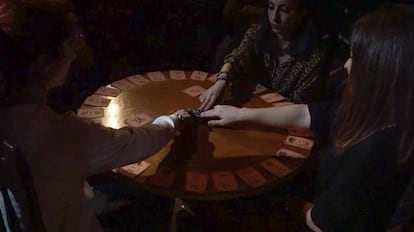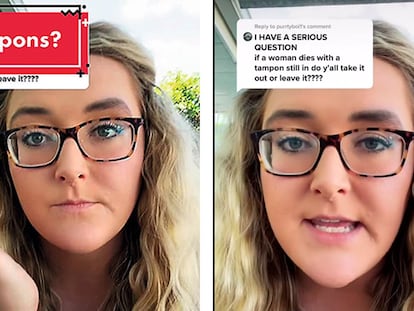The truth is in here: studying the minds of paranormal believers
A tendency to find patterns in random sequences, the brain’s need to connect cause and effect and a more intuitive thought process are some of the principle psychological mechanisms that explain belief in paranormal phenomena

When people talk about the paranormal, they are generally referring to apparitions, clairvoyance and other occurrences that defy the basic principles of scientific understanding. Although the perception exists that these spirits appear more often in times of crisis, such as during the coronavirus pandemic, in reality there must be a breeding ground in human psychology that allows them to flourish. Twenty years ago, the Spanish Centre for Sociological Research (CIS) conducted a survey in which 20% of Spaniards said they believe in ghosts and 9% in clairvoyance. At a time when conspiracy theories and other irrational explanations are on the increase, understanding the minds of those who place their faith in the paranormal could be the first step in unravelling its basis.
In an attempt to get to the bottom of the issue, a group of British researchers have reviewed the 71 scientific studies published over the past three decades with the goal of finding reliable patterns as to how believers think. Among all these papers, which look at factors as contrasting as education, intelligence or perception, there are few overlaps, according to the results of the study published in scientific journal Plos One. But it does draw three conclusions that can help us better understand why there are some people who see a blur in a photo and believe their great-great-grandfather is appearing to them.
One of the traits that defines such people is that they are less able to accept random events: that is to say, they have a greater tendency to see patterns where there are only randomly placed dots, or to see a face where there are only shadows. “Results show greater consistency when perceptual decision-making tasks involve identifying a human face/agent (rather than inanimate objects or animals), with believers making significantly more false-positive misidentifications than sceptics,” the study says in its summary. This factor is self-explanatory: if when presented with an ambiguous stimulus we believe we are seeing something as concrete and defined as a face, it is easier for unexplained phenomena to appear in our surroundings.
Neuroscientist Susana Martínez-Conde says the mechanism that explains it is clear: “The human brain is always trying to connect cause and effect or trying to find explanations to attribute significance to things that have none. A large amount of the information that surrounds us is random, chaotic and disorganized and our brain attempts to impose some kind of order. This has served us well during the course of human evolution, but of course we can also connect cause and effect in an incorrect way.” This is the basis of superstition and paranormal beliefs, Martínez-Conde says, and can even explain the illusions we experience at a magic show, when the magician waves his hand to make the rabbit disappear.
Upon reviewing the studies, the researchers - from the University of Hertfordshire and led by Charlotte E. Dean of the Department of Psychology, School of Life and Medical Sciences - found that this belief in the paranormal also occurs more regularly in those who jump to conclusions, although there is a significant lack of data to corroborate the possibility. In these cases, there would be a more accentuated natural tendency to confirm or reject one option without looking at possible alternative explanations: if a psychic levitates it is because they possess otherworldly powers.
Psychology professor Helena Matute and her team have studied this phenomenon and also observed the same mechanism. For example, they showed subjects medical records in which patients had been given medication or not given medication, which had either cured them or hadn’t. Those with paranormal beliefs were quicker to conclude the drug had worked, even though half of the patients had not been cured or hadn’t taken it in the first place. “They pay more attention when cause and effect coincide,” says Matute, of the University of Deusto. “It’s not that you’re seeing a ghost, it’s that you’re thinking too fast, which is tendency we all have.”
The pattern that best describes these subjects is their way of thinking, which is more intuitive than analytical. This aspect is closely linked to the findings of the Hertfordshire researchers, as it shows a tendency to trust in first impressions, to lean on instinct, as opposed to drawing conclusions via a more analytical process. A recent study showed that people who believe in parapsychology tend to be more satisfied with their lives than skeptics. The author of this work, David Gallo, says it is a tendency that has been observed in previous investigations and that “it could indicate that processing information in a more intuitive way has its advantages; it perhaps makes people happier in general.”
The paranormal and conspiracy theories
An interesting aspect of the University of Hertfordshire study it its relationship with conspiratorial thinking, which has occasionally even led to acts of political violence, and which could lead to a better understanding of these thought processes, at least from a cognitive point of view. “Conspiratorial beliefs are similarly associated with increased perception of illusory patterns, reduced need for cognitive reflection, and biases against confirmatory and non-confirmatory evidence,” the paper notes.
“What conspiracy theories and paranormal phenomena have in common is that we lack objective evidence to support them,” says Martínez-Conde, director of the Laboratory of Integrative Neuroscience at the State University of New York. “Furthermore, they arise from an experience that is more emotional than intellectual. As such, if someone is convinced from an emotional point of view that something is how it appears, it is very difficult to alter their opinion, even with objective evidence, and it becomes a question of faith.”
In the study, many factors that have previously been associated with paranormal thinking are either disproved or placed under question, because the relationship is either negative, weak or contradictory. For example, academic performance, critical thought, intelligence, memory (which could be the root cause of distortions or bias) have been proven to explain belief in paranormal phenomena. The researchers emphasize that there is no existing theoretical model that can accurately describe the mosaic of smaller explanations drawn by their review.
Matute concurs that there is still a lot of research to be done. “Many of us are studying paranormal beliefs, pseudo-medicines, post-truth and hoaxes. There are a lot of related aspects and until now they have been studied in a very separate way. Maybe it is true that we have to take the bull by the horns and unify all of this information: it is absolutely necessary to conduct deeper research into all of this.”
Tu suscripción se está usando en otro dispositivo
¿Quieres añadir otro usuario a tu suscripción?
Si continúas leyendo en este dispositivo, no se podrá leer en el otro.
FlechaTu suscripción se está usando en otro dispositivo y solo puedes acceder a EL PAÍS desde un dispositivo a la vez.
Si quieres compartir tu cuenta, cambia tu suscripción a la modalidad Premium, así podrás añadir otro usuario. Cada uno accederá con su propia cuenta de email, lo que os permitirá personalizar vuestra experiencia en EL PAÍS.
¿Tienes una suscripción de empresa? Accede aquí para contratar más cuentas.
En el caso de no saber quién está usando tu cuenta, te recomendamos cambiar tu contraseña aquí.
Si decides continuar compartiendo tu cuenta, este mensaje se mostrará en tu dispositivo y en el de la otra persona que está usando tu cuenta de forma indefinida, afectando a tu experiencia de lectura. Puedes consultar aquí los términos y condiciones de la suscripción digital.
More information
Últimas noticias
Most viewed
- Sinaloa Cartel war is taking its toll on Los Chapitos
- Oona Chaplin: ‘I told James Cameron that I was living in a treehouse and starting a permaculture project with a friend’
- Reinhard Genzel, Nobel laureate in physics: ‘One-minute videos will never give you the truth’
- Why the price of coffee has skyrocketed: from Brazilian plantations to specialty coffee houses
- Silver prices are going crazy: This is what’s fueling the rally











































